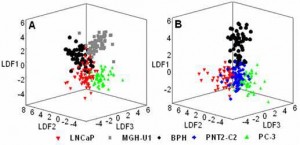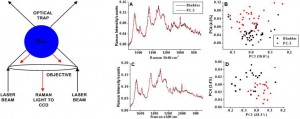Raman tweezers
Raman Tweezers – investigations into urine cytology
Prostate cancer (CaP) is the most commonly diagnosed cancer in men. About 32,000 cases of prostate cancer are diagnosed in the UK every year, which account for 23% of all male cancers. The median life expectancy for patients suffering from secondary prostate cancer in the bone is about 18 months. Current pre-operative methods of detection include digital rectal examination (DRE) and the prostate-specific antigen (PSA) test.
The PSA method measures the concentration of PSA (a glycoprotein) in the blood serum,but the threshold for a positive test is uncertain and a significant number of men will have cancer in the presence of a low PSA. Whilst both the PSA and DRE methods are sensitive to the presence of cancer, they suffer from low specifities resulting in a high false positive rate, and unnecessary biopsies.What the clinician requires is a non-invasive diagnostic tool that is both sensitive and specific. This will facilitate accurate diagnosis on the one hand and reduce the rate of unnecessary biopsies on the other. To this end we have used Raman laser tweezers to study bladder and prostate cells shed into urine.
The laser tweezers enable us to trap individual cells at the focus of a laser beam focused using a high numerical aperture. It is possible then to collect and analyse the scattered Raman light.
Average Raman spectra from prostate and bladder cells and the resulting principal components analysis (PCA) plots show that they can be broadly separated into two groups, although there is some overlap between them. More detailed studies using a number of different prostate and bladder cell types showed that the method could be refined and that high sensitivities and specificities could be obtained.

In this study both live and fixed cells have been used. The cell lines were initially studied in water/but the influence of exposure to urine has also been investigated. The next stage of this project will involve looking at clinical urine samples.
Publications related to this project
Classification of Fixed Urological Cells using Raman Tweezers
T. J. Harvey, C Hughes, A D Ward, E Correia Faria, A Henderson, N W Clarke, M D Brown, R D Snook, P Gardner
J. Biophotonics, 2 (2009) 47-69
Raman tweezers and their application to the study of singly trapped eukaryotic cells
R. D. Snook, T. J. Harvey, E. Correia Faria, P. Gardner
Integrative Biology, 1 (2009) 43-52
The Spectral Discrimination of Live Prostate and Bladder Cancer Cell Lines Using Raman Optical Tweezers
T. J. Harvey, E. Correia Faria, E Gazi, A D Ward, N W Clarke, M D Brown, R.D. Snook, P. Gardner
Journal of Biomedical Optics, 13 (2008) 064004
The Use of Raman Tweezers and Chemometric Analysis to Discriminate the Urological Cell Lines, PC-3, LNCaP, BPH and MGH-U1
T. J. Harvey, C. Hughes, A. D. Ward, E Gazi, E Correia Faria, N W Clarke, M Brown, R Snook P. Gardner
American Institute of Physics AIP Conference Proceedings Volume 1075, Perspectives in Vibrational Spectroscopy, Proceedings of the 2nd International Conference on Perspectives in Vibrational Spectroscopy (ICOPVS 2008) Eds V. K. Vaidyan and V. S. Jayakumar pp 138-140
Analysis of prostate and bladder cells using Raman tweezers
T J Harvey, C Hughes, A D Ward, E Gazi, E Correia Faria, N W Clarke, M Brown, R Snook, P Gardner
Proceedings of the XXI International Conference on Raman Spectroscopy, ICORS 2008, Eds R. Withnall and B. Z. Chowdhry, IM Publications Chichester, pp 1015-1017
Funding
- EPSRC/RSC Analytical Studentship
- STFC Lasers for Life Science
